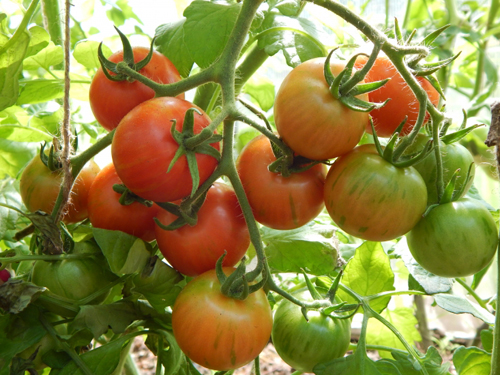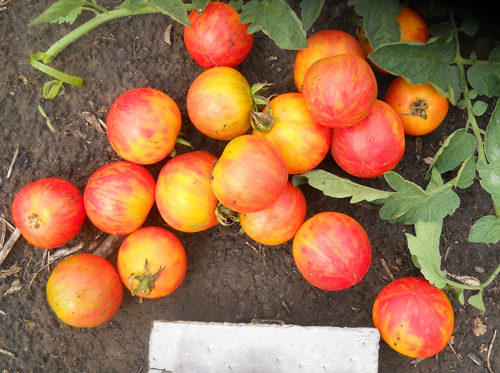Tomato variety Amur tiger
The unusual color of tomatoes has long and firmly entered the garden fashion. On the podium-beds, cultures of the most unusual colors flaunt. But there are still tomato growers who prefer the classic red-fruited varieties. I would like to advise such garden conservatives, as an experiment, to plant on the site an unusual, even exotic variety related to the so-called bicolors. She bears a rather loud name - the Amur tiger, and is recognized by many vegetable growers as the most delicious among the striped species. The novelty was announced not so long ago, in the 2014th year. Breeders of Agrofirma Aelita LLC worked on its creation. The unique tomato was included in the State Register of Breeding Achievements of Russia in 2015 and received admission in all regions of the country. Recommended for growing in open ground and under film shelters in personal subsidiary plots. Despite such a young age, the Amur tiger has already received enthusiastic responses, although, as always, it was not without criticism. But first things first.

Description
Plant of indeterminate type, 1.5 - 2.0 meters high. Shoot formation is moderate, foliage is above average. The stem and shoots are strong, rather thick, the root system is well developed. Leaves are of normal type, medium in size, with a slightly wrinkled surface, dark green in color. The overall impression of the bush is beautiful, powerful, but neat. The inflorescence is intermediate. The type of fruiting is carpal, so the overall yield is high. The first inflorescence forms above the 7th leaf, the subsequent ones appear every 3 leaves. In each fruit cluster of a tomato, 8 - 12 ovaries are formed. On the main stem of the Amur tiger, 20 - 25 tomatoes can form at the same time. The peduncle is articulated.
During the fruiting period, the bushes of this variety are an amazing sight. They are hung with fruits of an exotic color, which is unusual both at the stage of ripening and at full maturity. Tomatoes are leveled, flat-rounded, slightly ribbed, of medium density. The State Register describes tomatoes as large, weighing 240 grams. The originator claims a more modest weight of 120 - 150 grams. But there is a lot of confirmation from vegetable growers about large-fruited, the specimens grow really weighty, weighing up to 300 grams and even more. By the way, many tomato growers grow medium-sized tomatoes, weighing from 50 to 80 grams, such a result, of course, is disappointing. It can only be explained by re-grading. The description of the Amur Tiger states that all tomatoes in both the lower and upper brushes are the same size. But tomato growers disagree, noting that in the lower clusters the tomatoes are still larger than in the upper ones. The color of an unripe fruit is unusually beautiful - against a light green background, dark green stripes and spots appear in contrast, as if imitating a tiger coloration. In a mature state, the color of a true varietal tomato changes to red or chocolate, and the stripes remain green (and not yellow-orange, as many describe). The skin is thin, slightly glossy. The pulp is dark red, tender, juicy, aromatic. Seed chambers - 6 pieces. They are small, full, enough seeds. The State Register notes the taste as good. But, according to the reviews of those who grew the variety, the taste is excellent, the taste is sweet, with a slight sourness.

Characteristics
- In terms of ripening, the Amur tiger belongs to the mid-season. The period from the emergence of full shoots to the beginning of fruiting takes about 108 - 112 days;
- marketable fruit yield under film shelters, according to the State Register, amounted to 11.0 - 11.5 kg per 1 square meter. Approximately these indicators are confirmed by vegetable growers - about 3.0 kg is obtained from one plant, and from 1 sq. meters - about 11.0 kg;
- according to the observations of vegetable growers, the culture is able to withstand cold weather and show good results even in the open field.But the plant is not so resistant to too high temperatures - part of the flowers may be dropped, which, of course, affects the yield of the variety not for the better;
- there is information that some flowers suffer from doubleness, which will subsequently result in the formation of a large, but ugly tomato. Therefore, if a flower that is too large is found, it is better to remove it so that the plant spends its energy on the formation of "correct" tomatoes;
- if the Amur tiger is grown in an open garden in cool regions, then part of the harvest will not have time to ripen. In this case, the practice of removing tomatoes at the stage of blanche ripeness. In room conditions, these fruits ripen well and show the same good taste;
- the skin is thin, so our hero is prone to cracking large fruits;
- immunity is not described in the State Register, the originators also do not provide data on the resistance of the variety to certain diseases. But according to the general opinion of gardeners, the plant is quite resistant to major diseases both outdoors and indoors;

- the transportability of the crop harvested at the stage of technical ripeness is good. But a significant drawback is the too short shelf life.
- the way of eating fruits, according to the State Register, is universal. Tomatoes are suitable for making salads, processing into tomato products and whole-fruit canning. Regarding the latter method, the opinion of gardeners differs from the official source. Yes, in canning, the unusual color of the tomato is preserved, this, of course, is a plus. But the skin of the Amur tiger fruit does not withstand heat treatment and bursts, which does not color the contents of the jar at all.
Agrotechnics
Like most new varieties, our hero is best grown in seedlings. The sowing period recommended by the originators is from March 20 to April 10. But in each region, this period is significantly adjusted taking into account climatic features. In order to correctly determine the sowing time, taking into account all the nuances, you need to know that by the time of transplanting the seedlings should be about 55-60 days old. The seeds show almost 100% germination. Seed preparation and seedling cultivation are carried out in the usual way. The recommended stocking density of the Amur tiger is no more than 4 plants per 1 square meter. Like all indents, our hero needs a garter on a trellis. Docking must be carried out at least once a week so that the plant does not waste nutrients in vain. In a greenhouse, it is customary to form a plant in 1 stem, on the street - in 1 - 2 stems. But some tomato growers got good results when forming 3 - 4 stems. Thus, the bushes formed into 3 stems formed up to 10 fruit clusters. Experienced tomato growers recommend watering tomatoes twice a week in hot weather using the drip method. As a top dressing, universal balanced fertilizers or organic matter are used, for example, herbal infusions with the addition of ash.
The Amur tiger is still very young so that a complete picture can be created that fully characterizes this variety. But every year, small pieces of the mosaic will fold into a single canvas, and understanding how to grow this tomato more correctly, what it loves and what it doesn’t, will help tomato growers finally form their opinion about the variety. But it is already becoming clear that our hero will not become another passing grade. After all, many gardeners made it to the list of their favorite crops. Moreover, the seeds collected from the largest and most beautiful tomato next year can show the result no worse, and maybe even better than last year. But for the sake of objectivity, I must say that there were also those who were dissatisfied with the size of the tomatoes, their taste and thin skin, which does not save from cracking in the garden and in the jar.








